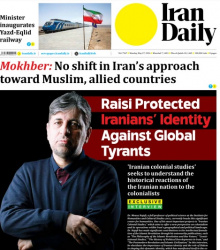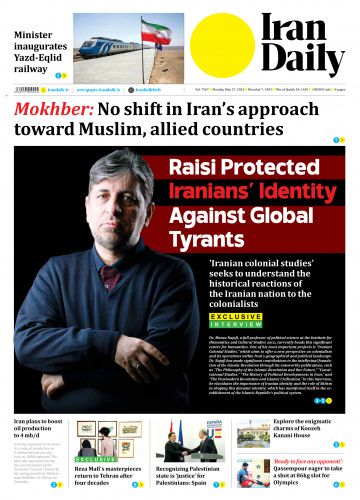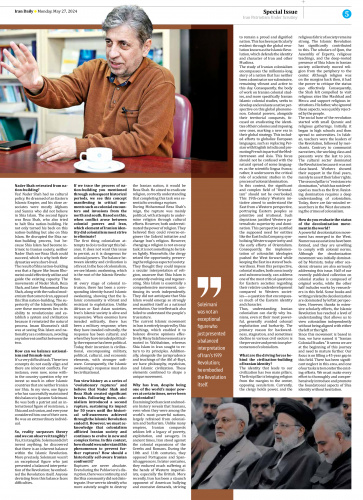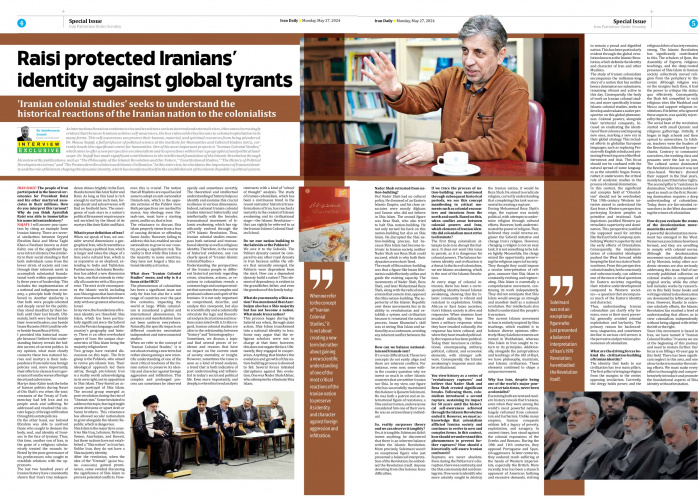دکتر نجفی در مصاحبه با ایراندیلی:
رئیسی از هویت ایرانیان در برابر ظالمان جهانی، محافظت کرد

روزنامه ایراندیلی که به زبان انگلیسی منتشر میشود، در شماره دوشنبه هفتم خرداد (27 می 2024) خود مصاحبهای از دکتر نجفی، رئیس پژوهشگاه علوم انسانی و مطالعات فرهنگی منتشر کرد که طی آن دکتر نجفی گفته است «رئیسی از هویت ایرانیان در برابر ظالمان جهانی، محافظت کرد».
پیوند و فایل پیدیاف این شماره ایراندیلی از نظرتان میگذرد:
All right reserved by Iran Newspaper
All rights reserved. © 1994-2024.
Iran Daily
Raisi protected Iranians’ identity against global tyrants
’Iranian colonial studies’ seeks to understand the historical reactions of the Iranian nation to the colonialists
As international tensions continue to rise and we witness various internal and external crises, it becomes increasingly evident that the more Iranians achieve self-awareness, the less vulnerable they become to colonial exploitation in its many forms. This self-awareness can protect their human, material, and spiritual resources from being plundered. Dr. Mousa Najafi, a full professor of political science at the Institute for Humanities and Cultural Studies (IHCS), currently heads this significant center for humanities. One of his most important projects is “Iranian Colonial Studies,” which aims to offer a new perspective on colonialism and its operations within Iran’s geographical and political landscape. Dr. Najafi has made significant contributions to the intellectual foundation of the Islamic Revolution through his noteworthy publications, such as “The Philosophy of the Islamic Revolution and Our Future,” “Constitutional Studies,” “The History of Political Developments in Iran,” and “The Postmodern Revolution and Islamic Civilization.” In this interview, he elucidates the importance of Iranian identity and the role of Shiism in shaping this dynamic identity, which has manifested itself in the establishment of the Islamic Republic’s political system.
By Amirhossein Somali
Guest contributer
IRAN DAILY: The people of Iran participated in the funeral ceremonies for President Raisi and his other martyred associates in their millions. How do you interpret this turnout? Why do you think Ayatollah Raisi was able to immortalize his name in Iranian history?
NAJAFI: I will answer your question by citing an example from Iranian history. There are several similarities between Seyyed Ebrahim Raisi and Mirza Taghi Khan-e Farahani known as Amir Kabir, one of the significant figures in Iran’s history. One similarity in their social standing is that both individuals came from the lower strata of society and rose through their inherent merit to accomplish substantial foundational work within approximately three years of leadership. This includes the implementation of a national and indigenous economy, a principle both firmly believed in. Another similarity is that both were people-oriented and deeply cared for the public; they stood steadfast by their beliefs until their last breath. Ultimately, both were buried beside their revered leaders, one beside Imam Hussein (PBUH) and the other beside Imam Reza (PBUH).
I provided this historical example because I believe that understanding history reveals the hidden secrets of current politics. In my opinion, what most closely connects these two national heroes and martyrs is their independence from nefarious foreign policies and, more importantly, their efforts to cleanse Iran’s governance from the waves of foreign deceit and subversion.
Martyr Amir Kabir took the helm of Iranian politics during Naser al-Din Shah’s era when the toxic remnants of the Treaty of Turkmenchay had left Iran and its people weak and suffering. He addressed and resolved this sinister legacy of foreign infiltration through his astute policies.
On the other hand, our beloved Ebrahim was able to confront those who sought to demean the body, soul, and identity of Iranians in the face of tyranny. Thus, this time, another son of Iran, in the guise of a religious scholar, wisely treated the wounds inflicted by the poor governance of his predecessors who sought to establish relations with the oppressors.
The last two hundred years of Iranian history have consistently shown that Iran’s true independence shines brightly in the East, thanks to men like Amir Kabir and Raisi. As long as this land is rich enough to nurture such men, foreign deceit and subservience will find no foothold here. The emergence of such stars in a nation’s political firmament requires pure soil enriched by the blood of its martyrs like Amir Kabir and Raisi.
What is your definition of Iran?
When we speak of Iran, we consider several dimensions: a geographical Iran, which resembles a cat in shape; a political Iran, which is larger and takes the shape of a lion; and a cultural Iran, which is as expansive as an elephant, extending to India and Tajikistan. Furthermore, the Islamic Revolution has added a new dimension to Iran, one that extends to virtually all countries with a Shia presence. The next circle encompasses the Islamic world, including non-Shia regions that have drawn closer to us due to their shared enmity with our greatest adversary, Israel.
In my view, the foundations of Iranian identity are threefold: Shia Islam, which has been particularly significant since the Safavid era; the Persian language; and the country’s geography and history. There is an often-overlooked aspect of Iran: the unique characteristic of Shia Islam being the majority religion here.
Two groups have resisted discussions on this topic. The first group is the Pahlavis, who aimed to revive pre-Islamic Iran. Their ideological approach led them astray, though pre-Islamic Iran is a reality worth acknowledging in its own right, not in opposition to Shia Islam. They feared an accurate portrayal of Shia Islam. The second group emerged as post-revolution during the rise of “Ummah-ism.” Some hesitated to address this topic, fearing it might create divisions or upset Arab or Sunni brothers. This reluctance has allowed secular nationalism to grow alongside the Islamic Republic, which is dangerous.
Shia Islam is the majority in countries like Iraq, Lebanon, Bahrain, Yemen, Azerbaijan, and Kuwait, but these nations have not established a “Shia nation” as Iran has. Unlike Iran, they do not have a Shia majority identity.
After the revolution, when the idea of the “Ummah” (global Muslim community) gained prominence, some avoided discussing the significance of Shia Islam to prevent potential conflicts. However, this is crucial. The notion that all Muslims are equal has led some to adopt an anti-nationalist Ummah-ism, which is the opposite extreme of the Pahlavi view. Both perspectives are marked by excess. Any ideology, even Ummah-ism, must have a starting point, and for us, that is Iran.
The reluctance to discuss Shia Islam properly stems from a fear of causing division or offending Sunni Arabs. However, failing to address this has enabled secular nationalism to grow in our country, posing a significant risk. The reality is that while Shia Islam is the majority in some countries, they have not forged a Shia national identity as Iran has.
What does “Iranian Colonial Studies” mean, and why is it a focus at the IHCS?
The phenomenon of colonialism has been a significant issue not only for Iran but also for a wide range of countries over the past few centuries, impacting the world at large. While colonialism is considered a global and international phenomenon, its presence and manifestation have not been uniform everywhere. Naturally, the specific impacts on different countries necessitate independent and interconnected studies.
When we refer to the concept of “Iranian Colonial Studies,” it is not about creating a new term but rather about gaining a new scientific understanding of one of the most critical reactions of the Iranian nation to preserve its identity and character against foreign aggression and infiltration. This complex and prolonged process can sometimes be observed openly and sometimes covertly. The theoretical and intellectual understanding of history helps us identify and examine this crucial resilience in various dimensions. Indeed, national Iranian colonial studies intersect historically and intellectually with the broader, transnational movement of Islamic awakening, which has significantly evolved through the 1979 Islamic Revolution. Thus, Iranian colonial studies encompass both national and transnational identity as well as religious identity. Therefore, in the course of historical evolution, one can clearly speak of “Iranian Islamic Colonial Studies.»
Understanding the perspectives of the Iranian people in different historical periods regarding crises, situations, actions, or reactions to colonialism reveals a common logic and a unique mindset that narrates the complex and profound culture and spirit of the Iranians. It is not only important to comprehend, describe, and analyze this viewpoint, but also to scientifically and academically articulate the logic and theoretical and practical actions and reactions associated with it. In this regard, Iranian colonial studies are akin to the relationship between “history” and “historiography.»
Sometimes, we discuss a topic and find several pieces of evidence and reasons that have no impact on the current state of society, mentality, or insight. However, sometimes the issue is seen as a kind of trend analysis, a trend that is both indicative of past understanding and influential in today’s social and political life. Even more importantly, and deeply, is when this trend analysis intersects with a kind of “school of thought” analysis. The study of Iranian colonialism, which has been a continuous trend in the recent centuries’ historical transformations of Iran, has reached a maturity in the context of Islamic awakening and its civilizational stage—the Islamic Revolution—that can rightly be referred to as the Iranian Islamic Colonial Studies School.
Do we owe nation-building to the Safavids or the Pahlavis?
We owe it to the Safavids. The Pahlavi dynasty cannot be compared to any other royal dynasty in Iran because unlike the others that naturally emerged, the Pahlavis were dependent from the start. How can a dependent dynasty build a nation? This element of dependency is evident in the grandfather, father, and even the grandson of this family today.
What do you mean by a Shia nation? You mentioned that Azerbaijan also has a Shia majority but has not become a nation. What made Iran a nation?
This process began during the Safavid era when, through state action, Shia Islam transformed into a national identity in Iran. Some may argue that the religious scholars were not in charge at that time; however, this does not negate the fact. Ultimately, they engaged in cooperation. Anything that hinders the evolution and growth of this nation-building process is doomed to fail. Several forces initiated disruptions against this evolution. One was Nader Shah Afshar, who attempted to eliminate Shia Islam.
Nader Shah retreated from nation-building?
Yes! Nader Shah had no cultural policy. He dreamed of an Eastern Islamic Empire, and his close associates were mostly Afghans and Sunnis who did not believe in Shia Islam. The second figure was Reza Shah, who also tried to halt Shia nation-building. He not only turned his back on this nation-building but also on Shia Islam. He disrupted the Shia nation-building process, but because Shia Islam had become intrinsic to Iranian society, neither Nader Shah nor Reza Shah could succeed, which is why both their dynasties were short-lived.
The result of Shia nation-building was that a figure like Imam Khomeini could effectively utilize and guide the existing capacity. The movements of Nader Shah, Reza Shah, and later Mohammad Reza Shah, along with the radical modernism that came to Iran, opposed this Shia nation-building. The superiority of the Islamic Republic over these movements lies in its ability to revolutionize and establish a system and civilization because it reinstated the natural process. Imam Khomeini’s skill was at seeing Shia Islam and nationality as a continuum, avoiding any inherent conflict between the two.
How can we balance nationalism and Ummah-ism?
It’s a very difficult task. These two concepts do not easily align and there are inherent conflicts. For instance, even now, some within the country question why we invest so much in other Islamic countries that are neither Iranian nor Shia. In my view, one figure who has successfully maintained this balance is Qassem Soleimani. He was both a patriot and an international figure of resistance, a Shia and an Iranian, and everyone considered him one of their own. He was an extraordinary individual.
So, reality surpasses theory and we can observe it tangibly?
Yes, it is tangible. Soleimani didn’t invent anything; he discovered that there is an inherent balance within the Islamic Revolution. More precisely, Soleimani wasn’t an exceptional figure who just presented a balanced interpretation of the Revolution; he embodied the Revolution itself. Anyone deviating from this balance faces difficulties.
If we trace the process of nation-building you mentioned through subsequent historical periods, we see this concept manifesting in critical moments such as colonial encounters and invasions from the north and south. Based on this, when conflict arose between colonial powers and Iran, which element of Iranian identity did colonialism most strive to eliminate?
The first thing colonialism attempts to do is to disrupt this balance. It does not want this issue to persist, as it is dangerous for colonial powers. The balance between identity and civilization is a threat. In the face of colonialism, we see Islamic awakening, which is the root of the Islamic Revolution.
At every stage of colonial intrusion, there has been a corresponding identity-based Islamic awakening, showing that the Islamic community is vibrant and resistant to exploitation. Unlike African or East Asian societies, Iran’s Islamic society is alive and responsive. When enemies have invaded militarily, there has been a military response; when they have invaded culturally, the response has been cultural; and when they have invaded politically, the response has been political. Today, their incursion is civilizational, encompassing military, political, cultural, and economic elements, with stronger software. Consequently, the Islamic awakening’s response must also be civilizational.
You view history as a series of “evolutionary ruptures” and believe that Nader Shah and Reza Shah created significant breaks. Following them, colonialism introduced a second rupture, sustaining its impact for 50 years until the historical self-awareness achieved through the Islamic Revolution ended it. However, we must acknowledge that colonialism afflicted Iranian society and continues to evolve in new and complex forms. In this context, how should we understand this phenomenon to prevent further ruptures? How should a historically self-aware Iranian confront it?
Ruptures are never absolute. Even during the Pahlavi era’s disruption, there was continuity, and the Shia community did not disintegrate. If we were to identify who more astutely sought to destroy the Iranian nation, it would be Reza Shah. He aimed to eradicate religion, correctly understanding that completing this task was essential to creating a rupture.
During Mohammad Reza Shah’s reign, the rupture was mainly political, with attempts to undermine religion through cultural efforts. However, both underestimated the power of religion. They believed they could reverse-engineer the Safavid initiative and change Iran’s religion. However, changing a religion is not an easy task; it is not something to be taken lightly. Meanwhile, the clergy seized the opportunity, preserving the religious aspect of society.
They thought they could impose a secular interpretation of religion, unaware that Shia Islam is constantly evolving and regenerating. Shia Islam is essentially a comprehensive movement, continuing its work independently. They did not anticipate that Shia Islam would emerge so strongly and manifest itself as a national revolution. Our intellectuals also failed to understand the people’s true nature.
The current Islamic movement in Iran is entirely inspired by Shia teachings, which enabled it to balance diverse opinions effectively. Many Salafi movements are rooted in Wahhabism, whereas Shia Islam in Iran sought to return to its principles. Additionally, alongside the jurisprudence and teachings of the Ahl al-Bayt, we have philosophy, mysticism, and Islamic civilization. These elements combined to shape a unique movement.
Why has Iran, despite being one of the world’s major powers at certain times, never been a colonialist?
Examining both ancient and modern history reveals that Iranians, even when they were among the world’s most powerful nations, largely refrained from colonialism and barbarism. Unlike many empires, Iranian conquests seldom left a legacy of poverty, exploitation, and savagery. In ancient times, Iran stood against the colonial expansions of the Greeks and Romans. During the 10th and 11th centuries, they opposed Portuguese and Spanish aggressors. In later centuries, they endured much suffering at the hands of Western imperialists, especially the British. More recently, Iran has been a staunch opponent of American bullying and excessive demands, striving to remain a proud and dignified nation. This has been particularly evident through the global revolution known as the Islamic Revolution, which defends the identity and character of Iran and other Muslims.
The study of Iranian colonialism encompasses the millennia-long story of a nation that has neither been a dominator nor submissive, remaining vibrant and active to this day. Consequently, the body of work on Iranian colonial studies, and more specifically Iranian Islamic colonial studies, seeks to develop and evaluate a native perspective on this global phenomenon. Colonial powers, alongside their territorial conquests, focused on eradicating the identities of their colonies and imposing new ones, marking a new era in their global strategy. This included efforts to globalize European languages, such as replacing Persian with English in India and promoting French in parts of the Mediterranean and Asia. This focus should not be confused with the natural spread of some languages as the scientific lingua franca; rather, it underscores the critical role of academic studies in the process of colonial domination.
In this context, the significant and complex field of “Orientalism” should not be overlooked. This 19th-century Western initiative aimed to understand the East from a Western perspective, portraying Eastern peoples as primitive and irrational. Such depictions justified Western paternalistic superiority and domination. This perspective justified the supposed need for entities like the East India Company, symbolizing Western superiority and the early efforts of Orientalism. Consequently, the implementation of colonialist ideologies pushed the West forward while keeping the East in a state of backwardness. From this perspective, colonial studies, both consciously and subconsciously, can address one of the most critical questions for Eastern societies regarding their relative underdevelopment compared to Western societies—a question that encompasses much of the Eastern identity and character.
Thus, understanding Iranian colonialism can clarify why Iranians, even at their most powerful, generally avoided colonial exploitation and barbarity. The primary reason for backwardness, stagnation, and sometimes decline in various civil sectors is the pervasive and pernicious phenomenon of colonialism.
What are the driving forces behind the civilization-building of Iranian identity?
The identity that leads to our civilization has two main pillars. The first pillar is bringing religion from the margins to the center, opposing secularism. Currently, the clergy holds power, and the religious fabric of society remains strong. The Islamic Revolution has significantly contributed to this. The scholars of Qom, the Assembly of Experts, religious teachings, and the deep-rooted presence of Shia Islam in Iranian society collectively moved religion from the periphery to the center. Although religion was on the margins back then, it had the power to critique the status quo effectively. Consequently, the Shah felt compelled to visit religious sites like Mashhad and Mecca and support religious institutions. His father, who ignored these aspects, was quickly rejected by the people.
The social base of the revolution started with small Quranic and religious gatherings. Initially, it began in high schools and then spread to universities. In Isfahan, teachers were the leaders of the Revolution, followed by merchants. Contrary to communist narratives, the working class and peasants were the last to join. The cultural sector dominated the Revolution because it was not class-based. Workers showed their support in the final years, mainly to assert their labor rights.
The second pillar is “resistance to domination,” which has not developed as much as the first. Resisting domination requires a deep understanding of colonialism. Today, there are fair-minded researchers in the West documenting the crimes of colonialism.
How do you evaluate the status of the decolonization movement in the world?
A powerful decolonization movement has emerged in the West. Numerous associations have been formed, and they are unwilling to comply with colonial norms. Although the decolonization movement was initially dominated by Marxists, today other academic streams are also seriously addressing this issue. Half of our recently published collection on colonial studies is composed of original works, while the other half includes works by researchers in this field. Some books and writings related to decolonization are dominated by leftist perspectives. However, thanks to extensive scholarly efforts, the Islamic Revolution has reached a level of understanding that allows us to view colonialism independently without being aligned with either the left or the right.
Since this movement is based in Iran, we have named it “Iranian Colonial Studies.” It seems we are at the beginning of this journey and need to mature further. Our focus is on filling a 45-year gap in this field. There has been significant neglect in this area, and one of our tasks is to monitor the existing efforts. We must make every effort to thoroughly and comprehensively introduce and promote the foundational aspects of Shia identity without hesitation.
Search
Date archive







نظر شما :